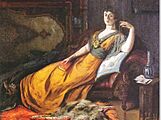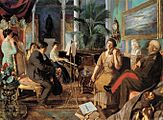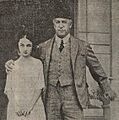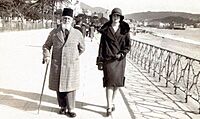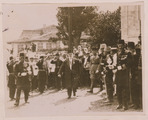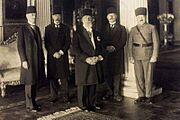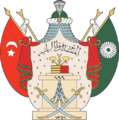Abdülmecid II facts for kids
Quick facts for kids Abdulmejid II |
|||||
|---|---|---|---|---|---|

Official portrait of Caliph Abdulmejid II
|
|||||
| Ottoman caliph (Halîfe-i Müslimîn) |
|||||
| Tenure | 19 November 1922 – 3 March 1924 | ||||
| Predecessor | Mehmed VI | ||||
| Successor | Caliphate abolished | ||||
| Head of the Osmanoğlu family | |||||
| Reign | 16 May 1926 – 23 August 1944 | ||||
| Predecessor | Mehmed VI | ||||
| Successor | Ahmed Nihad | ||||
| Born | 29/30 May 1868 Beşiktaş, Istanbul, Ottoman Empire |
||||
| Died | 23 August 1944 (aged 76) Paris, France |
||||
| Burial | Al-Baqi', Medina, Saudi Arabia | ||||
| Consorts |
Şehsuvar Kadın
(m. 1896)Hayrünnisa Kadın
(m. 1902; died 1936)Mihrimah Bihruz Kadın
(m. 1912)Atiye Mehisti Kadın
(m. 1912) |
||||
| Issue |
|
||||
|
|||||
| Dynasty | Ottoman | ||||
| Father | Abdulaziz | ||||
| Mother | Hayranidil Kadın | ||||
| Religion | Sunni Islam | ||||
Abdülmecid II or Abdulmejid II (Ottoman Turkish: عبد المجید ثانی, romanized: ʿAbdü'l-Mecîd-i sânî; Turkish: II. Abdülmecid; 29 May 1868 – 23 August 1944) was the last Ottoman caliph, the only caliph of the Republic of Turkey, and head of the Osmanoğlu family from 1926 to 1944. As opposed to previous caliphs, he used the title Halîfe-i Müslimîn (Caliph of the Muslims), instead of Emîrü'l-Mü'minîn (Commander of the Faithful).
He was also a relatively famous artist and a Turkish aesthete, interested in art and the ways to promote it, mainly literature, painting and music, in Turkey. After the abolition of the Ottoman caliphate, he was succeeded for a few months by Hussein bin Ali, who was mostly recognized in the Arab world, but that attempt ended as well.
He died in Paris in 1944 and was buried as a caliph in Medina.
Contents
Biography
Early years
On 30 May 1868, he was born at Dolmabahçe Palace, Beşiktaş, Istanbul, to then Sultan Abdulaziz and his consort Hayranidil Kadın. He was the younger full brother of Nazime Sultan. He was educated privately. According to testimonies, he agreed with marriages between cousins within the Ottoman dynasty to reduce tensions within the dynasty.
In accordance with late Ottoman custom, Abdulmejid was confined to the palace until he was 40. On 4 July 1918, his first cousin Mehmed VI became Sultan and Abdulmejid was named Crown Prince. He was interested in literature and founded the Pierre Loti Society in 1920 to promote the works of the author and translate them into Turkish. He had a genuine interest in painting as well, and himself painted a lot, trying to develop realist art in the Ottoman Empire and in music, for he was a composer also. He played the piano.
Caliphate
When his cousin was deposed on 1 November 1922, the Ottoman Sultanate was abolished. But on 19 November 1922, the Crown Prince was elected Caliph by the Turkish National Assembly at Ankara. He established himself in Istanbul on 24 November 1922. The choice of Abdulmejid as caliph was not evident for all Muslims, and there was a significant amount of Islamic and political criticism from within and outside the Ottoman Empire. There was indeed a conflict among certain Muslims, for example in Palestine, who opposed the figures of Hussein bin Ali and Abdulmejid to succeed Mehmed VI. Western colonial powers, such as France or the United Kingdom, were very attentive to these developments. One of those critics was Muhammad Rashid Rida, who claimed that he lacked some of the qualities needed to be the caliph.
However, even though he was criticized when he assumed the position, it seems that the vast majority of Muslims chose to recognize him.
Abdulmejid was targeted by Kemalist propaganda which used the fact that he occupied the Yıldız Palace in Istanbul, and he was subsequently portrayed as having unjustly claimed it for himself. He was also unhappy about the transfer of certain responsibilities from Istanbul to Ankara; for instance, he was angry about the relocation of a military band unit.
On 3 March 1924, six months after the foundation of the Turkish Republic, the Ottoman Caliphate was abolished and the Ottoman dynasty was deposed and expelled from Turkey.
Exile and death
The caliph was nominally the supreme religious and political leader of all Muslims across the world, with the main goal to prevent extremism or protect the religion from corruption. In the last session of the budget negotiations on 3 March 1924, Urfa Deputy Sheikh Saffet Efendi and his 53 friends demanded the abolition of the caliphate, arguing it was not necessary anymore. This was approved by majority of the votes and a law was established. With the same law, it was decided to expel all members of the Ottoman dynasty. Mustafa Kemal Atatürk, however, offered the caliphate to Ahmed Sharif as-Senussi, on the condition that he reside outside Turkey; Senussi declined the offer and confirmed his support for Abdulmejid. He was succeeded by Hussein bin Ali in the Arab world, with the support of his cousin, Mehmed VI but that attempt ended fast as well.
Although Abdülmecid and his family were upset about this decision, they did not want the people to revolt, so they secretly went to Çatalca by car from the Dolmabahçe Palace at 5:00 the next morning. Here, after being hosted by the head of the Rumeli Railways Company for a while, they were put on the Simplon Express. When he left Turkey, he traveled to Switzerland. However, contrary to expectations, he was not greeted by a delegation or ceremony but simply as an ordinary traveler. He was also in a difficult financial situation.
When Abdulmejid II arrived in Switzerland, he was detained at the border for a while, but was admitted to the country after a delay. In Switzerland, he said multiple times that he was upset about the abolition of the caliphate, and that this would bring chaos to the Islamic world, with the rise of extremism. But after the Turkish government put pressure on the Swiss government, Abdulmejid was never allowed to give such speeches in Switzerland again. After staying in Switzerland for a while, he moved to Nice, France in October 1924.
Abdulmejid lived a quiet life in Nice, France. His daughter Dürrüşehvar Sultan and his niece Nilüfer Hanım Sultan married the sons of the Nizam of Hyderabad, one of the richest people in the world; thanks to this, his financial situation improved. As he didn't get the anticipated support from the Islamic world for the restoration of the caliphate, he started to focus more on worship, painting, and music.
Abdulmejid, who later settled in Paris, used to perform Friday prayers at the Grand Mosque of Paris with other Muslims in the region. After the departure of his very fond grandchildren and son, who left France to marry the Kavala princes of Egypt, he spent painful days alone. He wrote a 12-volume book of memoirs, preserved by his daughter Dürrüşehvar Sultan.
On 23 August 1944, Abdulmejid II died at his house in the 15th Avenue du Maréchal Mounoury, Paris, due to a heart attack. His death coincided with the Liberation of Paris from the German occupation. Despite the efforts of Dürrüşehvar Sultan, the Turkish government did not permit his funeral to be held in Turkey. Subsequently, his remains were preserved at the Grand Mosque of Paris for ten years. Finally, when the mosque could no longer maintain his body, his body was subsequently moved to Medina, where he was then buried. His predecessor, Mehmed VI, was buried in Damascus, by Faisal I. This is explained by the prohibition imposed by the Kemalists, Atatürk and then İnönü, who prohibited them from being buried in Turkey.
As artist
Abdulmejid was given the title of General in the Ottoman Army, but did not have strong military inclinations. He had a more significant role as Chairman of the Ottoman Artists' Society and was a personal friend of some Western painters, such as Fausto Zonaro, who was influential in art in the Ottoman Empire. He was also connected to the French artist Adolphe Thalasso, who dedicated some works to him.
He is considered one of the most important painters of late period Ottoman art. His paintings of the Harem, showing a modern musical gathering, and of his wife, Şehsuvar Hanım, reading Goethe's novel Faust, express the influence of western Europe in his elite circle. These were displayed at a 1918 exhibition of Ottoman paintings in Vienna. His personal self-portrait can be seen at Istanbul Modern.
Abdulmejid was also an avid collector of butterflies, an activity that he pursued during the last 20 years of his life. His favourite magazine was Revue des deux Mondes.
Paintings
-
Painting of Abdülhak Hamit Tarhan, with the text in Ottoman Turkish saying, "made with the heart".
Personal life
Abdülmecid's first wife was Şehsuvar Hanım, a Turk or an Ubykh. They married on 23 December 1896. She was the mother of Şehzade Ömer Faruk, born in 1898. She died in Paris in 1945, and was buried in Bobigny cemetery. His second wife was Mihrimah Hanım. She died at the Nakkaştepe Palace, on 23 May 1899, and was buried in Nuhkuyusu Mosque, Istanbul.
His third wife was Hayrünissa Hanım, a Circassian. She was childless. His fourth wife was Mehisti Hanım. She was a Circassian-Abkhazian. Her father was Akalsba Hacımaf Bey, and her mother was Safiye Hanım. They married on 16 April 1912. She was the mother of Dürrüşehvar Sultan (who married Azam Jah, son of Mir Osman Ali Khan), born in 1914. She died in Middlesex, London in 1964, and was buried in Brookwood cemetery.
-
Abdulmejid II with his daughter Dürrüşehvar and fourth wife Mehisti Hanım
-
Princess Dürrüşehvar Sultan, Princess of Berar; Caliph Abdulmejid II of the Ottoman dynasty, and Nawab Azam Jah, Prince of Berar, 1931
-
Portrait of Abdulmejid II in Topkapı Palace Museum
Honours and arms
Ottoman honours
- Order of House of Osman, Jeweled
- Order of Glory, Jeweled
- Imtiyaz Medal, Jeweled
- Order of Osmanieh, Jeweled
- Order of the Medjidie, Jeweled
- Iftikhar Sanayi Medal
- Imtiyaz War Medal in Gold
- Outstanding Navy Medal in Gold
Foreign honours
 Austria-Hungary: Grand-Cross Order of Leopold, 6 June 1918
Austria-Hungary: Grand-Cross Order of Leopold, 6 June 1918 Persia: Order of the Crown, 2nd Class, 23 August 1919
Persia: Order of the Crown, 2nd Class, 23 August 1919
Arms
Family
Consorts
Abdülmejid II had four consorts:
- Şehsuvar Kadın (2 May 1881–1945). They married on 22 December 1896 and had a son.
- Hayrünnisa Kadın (2 March 1876-3 September 1936). She was born in Bandirma, Turkey. They married on 18 June 1902 in Ortakoy Palace. She died in Nice. Hayrünisa was extremely well educated and a cello virtuoso. She was portrayed by her husband while playing.
- Mihrimah Bihruz Kadın (24 May 1893–1955). She was born in İzmit. They married on 21 March 1912 in Çamlıca Palace. She died in Istanbul.
- Atiye Mehisti Kadın (27 January 1892–1964). She was born in Adapadari. They married on 16 April 1912 in Bağlarbaşı Palace and had a daughter. She died in London.
Issue
Abdülmejid II had a son and a daughter:
- Şehzade Ömer Faruk (27 February 1898 - 28 March 1969) - with Şehsuvar Kadın. Married twice with two his cousins and had three daughters by his first marriage.
- Hatice Hayriye Ayşe Dürrüşehvar Sultan (26 January 1914 - 7 February 2006) - with Mehisti Kadın. She married an Indian prince and had two sons.
See also
- Line of succession to the former Ottoman throne


